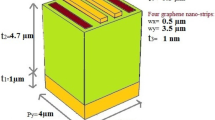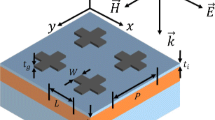Abstract
The organic non-crystalline medium of 5,6-dichloro-2-[[5,6-dichloro-1-ethyl-3-(4-sulfobutyl)-benzimidazol-2-ylidene]-propenyl]-1-ethyl-3-(4-sulfobutyl)-benzimidazolium hydroxide (TDBC) is emerging as possible alternative plasmonic material for noble metal in visible region. In this paper, a novel long-range surface exciton-polariton (LRSEP) sensor based on TDBC film covered with graphene is reported. To enhance the imaging sensitivity, the thickness of TDBC film and the number of graphene layers are optimized. The result shows that the optimized imaging sensitivity is enhanced to 3243 RIU−1 when ns = 1.34. Compared with the traditional noble metal film-based sensor, the proposed LRSEP sensor demonstrates that the imaging sensitivity has been greatly improved. This is the first study of the TDBC film-based LRSEP sensor, which we hope to support the potential development of chemical sensing and bio-sensing.









Similar content being viewed by others
Data Availability
The data that support the findings of this study are available from the corresponding author upon reasonable request.
References
Hirabayashi I, Tokura Y, Koda T (1982) Surface exciton polariton in ZnO. J Phys Soc Jpn 51(9):2934–2946. https://doi.org/10.1143/JPSJ.51.2934
Hirabayashi I, Koda T, Tokura Y, Murata J, Kaneko Y (2007) Surface exciton polariton in CuCl and CuBr. J Phys Soc Jpn 51(1):173–180. https://doi.org/10.1143/JPSJ.43.173
Takatori K, Okamoto T, Ishibashi K, Micheletto R (2017) Surface exciton polaritons supported by a J-aggregate-dye/air interface at room temperature. Opt Lett 42(19):3876–3879. https://doi.org/10.1364/OL.42.003876
Xu Y, Wu L, Ang LK (2019) Surface exciton polaritons: a promising mechanism for refractive-index sensing. Physical Review Applied 12 (2). https://doi.org/10.1103/PhysRevApplied.12.024029
Justino CIL, Rocha-Santos TA, Duarte AC, Rocha-Santos TA (2010) Review of analytical figures of merit of sensors and biosensors in clinical applications. TrAC, Trends Anal Chem 29(10):1172–1183. https://doi.org/10.1016/j.trac.2010.07.008
Xue T, Qi K, Hu C (2019) Novel SPR sensing platform based on superstructure MoS2 nanosheets for ultrasensitive detection of mercury ion. Sens Actuators B Chem 284:589–594. https://doi.org/10.1016/j.snb.2019.01.004
Granqvist N, Hanning A, Eng L, Tuppurainen J, Viitala T (2013) Label-enhanced surface plasmon resonance: a new concept for improved performance in optical biosensor analysis. Sensors 13(11):15348–15363. https://doi.org/10.3390/s131115348
Yue C, Lang Y, Zhou X, Liu Q (2019) Sensitivity enhancement of an SPR biosensor with a graphene and blue phosphorene/transition metal dichalcogenides hybrid nanostructure. Appl Opt 58(34):9411–9420. https://doi.org/10.1364/AO.58.009411
Han L, Zhao X, Huang T, Ding H, Wu C (2019) Comprehensive study of phase-sensitive spr sensor based on metal–ITO hybrid multilayer. Plasmonics 14(6):1743–1750. https://doi.org/10.1007/s11468-019-00968-z
Das CM, Ouyang Q, Dinh X-Q, Coquet P, Yong K-T (2020) A theoretical insight into the use of anti-reflective coatings for the upliftment of sensitivity of surface plasmon resonance sensors. Opt Commun 458:124748. https://doi.org/10.1016/j.optcom.2019
Nguyen HH, Park J, Kang S, Kim M (2015) Surface plasmon resonance: a versatile technique for biosensor applications. Sensors (Basel) 15(5):10481–10510. https://doi.org/10.3390/s150510481
Patil PO, Pandey GR, Patil AG, Borse VB, Deshmukh PK, Patil DR, Tade RS, Nangare SN, Khan ZG, Patil AM, More MP, Veerapandian M, Bari SB (2019) Graphene-based nanocomposites for sensitivity enhancement of surface plasmon resonance sensor for biological and chemical sensing: a review. Biosens Bioelectron 139:111324. https://doi.org/10.1016/j.bios.2019.111324
Sarid D (1981) Long-range surface-plasma waves on very thin metal films. Phys Rev Lett 47(26):1927–1930. https://doi.org/10.1103/PhysRevLett.47.1927
Xu Y, Hsieh CY, Wu L, Ang LK (2019) Two-dimensional transition metal dichalcogenides mediated long range surface plasmon resonance biosensors. Journal of Physics D: Applied Physics 52 (6). https://doi.org/10.1088/1361-6463/aaf0f7
Wu L, Ling Z, Jiang L, Guo J, Dai X, Xiang Y, Fan D (2016) Long-range surface plasmon with graphene for enhancing the sensitivity and detection accuracy of biosensor. IEEE Photonics J 8(2):1–9. https://doi.org/10.1109/jphot.2016.2533923
Li Y, Peng X, Song J, Yuan Y, Liu J, Qu J (2019) Ultrasensitive deep-ultraviolet surface plasmon resonance sensors using aluminum-graphene metasurface: a theoretical insight. Plasmonics 15(1):135–143. https://doi.org/10.1007/s11468-019-01015-7
Jia Y, Li Z, Wang H, Saeed M, Cai H (2019) Sensitivity enhancement of a surface plasmon resonance sensor with platinum diselenide. Sensors (Basel) 20 (1). https://doi.org/10.3390/s20010131
Han L, Pan J, Wu C, Li K, Ding H, Ji Q, Yang M, Wang J, Zhang H, Huang T (2020) Giant Goos-Hanchen shifts in Au-ITO-TMDCs-graphene heterostructure and its potential for high performance sensor. Sensors (Basel) 20 (4). https://doi.org/10.3390/s20041028
Pal S, Verma A, Prajapati YK, Saini JP (2017) Influence of black phosphorous on performance of surface plasmon resonance biosensor. Opt Quantum Electron 49 (12). https://doi.org/10.1007/s11082-017-1237-7
Wu L, Zhu J, Gan S, Ma Q, Dai X, Xiang Y (2019) Application of few-layer transition metal dichalcogenides to detect the refractive index variation in lossy-mode resonance sensors with high figure of merit. IEEE Sens J 19(13):5030–5034. https://doi.org/10.1109/jsen.2019.2904199
Dai X, Song C, Qiu C, Wu L, Xiang Y (2019) Theoretical investigation of multilayer Ti3C2Tx MXene as the plasmonic material for surface plasmon resonance sensors in near infrared region. IEEE Sens J 19(24):11834–11838. https://doi.org/10.1109/jsen.2019.2937843
Wu L, Guo J, Dai X, Xiang Y, Fan D (2017) Sensitivity enhanced by MoS2–graphene hybrid structure in guided-wave surface plasmon resonance biosensor. Plasmonics 13(1):281–285. https://doi.org/10.1007/s11468-017-0511-7
AlaguVibisha G, Nayak JK, Maheswari P, Priyadharsini N, Nisha A, Jaroszewicz Z, Rajesh KB, Jha R (2020) Sensitivity enhancement of surface plasmon resonance sensor using hybrid configuration of 2D materials over bimetallic layer of Cu–Ni. Opt Commun 463:125337. https://doi.org/10.1016/j.optcom.2020
Zhao Y, Wu L, Gan S, Ruan B, Zhu J, Dai X, Xiang Y (2018) High figure of merit lossy mode resonance sensor with graphene. Plasmonics 14(4):929–934. https://doi.org/10.1007/s11468-018-0876-2
Zeng S, Hu S, Xia J, Anderson T, Dinh X-Q, Meng X-M, Coquet P, Yong K-T (2015) Graphene–MoS2 hybrid nanostructures enhanced surface plasmon resonance biosensors. Sensors Actuators B Chem 207:801–810. https://doi.org/10.1016/j.snb.2014.10.124
Ji L, Chen Y, Yuan YJ (2014) Investigation of surface plasmon resonance phenomena by finite element analysis and Fresnel calculation. Sens Actuators B Chem 198:82–86. https://doi.org/10.1016/j.snb.2014.02.105
Xu Y, Wu L, Ang LK (2019) MoS2-based highly sensitive near-infrared surface plasmon resonance refractive index sensor. IEEE J Sel Top Quantum Electron 25(2):1–7. https://doi.org/10.1109/jstqe.2018.2868795
Maharana PK, Jha R, Pandhy P (2015) On the electric field enhancement and performance of SPR gas sensor based on graphene for visible and near infrared. Chemical, Sensors and Actuators B. https://doi.org/10.1016/j.snb.2014.10.006
Han L, He X, Ge L, Huang T, Ding H, Wu C (2019) Comprehensive study of SPR biosensor performance based on Metal-ITO-graphene/TMDC hybrid multilayer. Plasmonics 14(6):2021–2030. https://doi.org/10.1007/s11468-019-01004-w
Wu L, Guo J, Wang Q, Lu S, Dai X, Xiang Y, Fan D (2017) Sensitivity enhancement by using few-layer black phosphorus-graphene/TMDCs heterostructure in surface plasmon resonance biochemical sensor. Sens Actuators B Chem 249:542–548. https://doi.org/10.1016/j.snb.2017.04.110
Mishra AK, Mishra SK (2017) MgF2 prism/rhodium/graphene: efficient refractive index sensing structure in optical domain. J Phys Condens Matter 29 (14). https://doi.org/10.1088/1361-648X/aa5e40
Meshginqalam B, Ahmadi MT, Ismail R, Sabatyan A (2016) Graphene/graphene oxide-based ultrasensitive surface plasmon resonance biosensor. Plasmonics 12(6):1991–1997. https://doi.org/10.1007/s11468-016-0472-2
Han L, Wu C (2018) A phase sensitivity-enhanced surface plasmon resonance biosensor based on ITO-graphene hybrid structure. Plasmonics 14(4):901–906. https://doi.org/10.1007/s11468-018-0872-6
Rahman MS, Anower MS, Hasan MR, Hossain MB, Haque MI (2017) Design and numerical analysis of highly sensitive Au-MoS2-graphene based hybrid surface plasmon resonance biosensor. Opt Commun 396:36–43. https://doi.org/10.1016/j.optcom.2017.03.035
Shushama KN, Rana MM, Inum R, Hossain MB (2017) Graphene coated fiber optic surface plasmon resonance biosensor for the DNA hybridization detection: simulation analysis. Opt Commun 383:186–190. https://doi.org/10.1016/j.optcom.2016.09.015
Wu L, Jia Y, Jiang L, Guo J, Dai X, Xiang Y, Fan D (2017) Sensitivity improved SPR biosensor based on the MoS2/graphene–aluminum hybrid structure. J Lightwave Technol 35(1):82–87. https://doi.org/10.1109/jlt.2016.2624982
Funding
This work is partially supported by the National Natural Science Foundation of China (NSFC) (61771419) and Hebei Province Innovation Foundation for Postgraduate (CXZZSS2020051).
Author information
Authors and Affiliations
Contributions
Methodology and writing—original draft preparation, Na Liu; financial support, Jiangtao Lv; software and figure, Qi Cheng and Bo Pang; review and editing, Shutao Wang. All authors have read and agreed to the published version of the manuscript.
Corresponding authors
Ethics declarations
Conflict of Interest
The authors declare that they have no competing interest.
Consent for Publication
All authors agree to publish this article.
Additional information
Publisher’s Note
Springer Nature remains neutral with regard to jurisdictional claims in published maps and institutional affiliations.
Rights and permissions
About this article
Cite this article
Liu, N., Wang, S., Cheng, Q. et al. Characteristics of Refractive-Index Sensor in Graphene-Modified Long-Range Surface Exciton-Polaritons. Plasmonics 16, 1079–1088 (2021). https://doi.org/10.1007/s11468-020-01366-6
Received:
Accepted:
Published:
Issue Date:
DOI: https://doi.org/10.1007/s11468-020-01366-6




